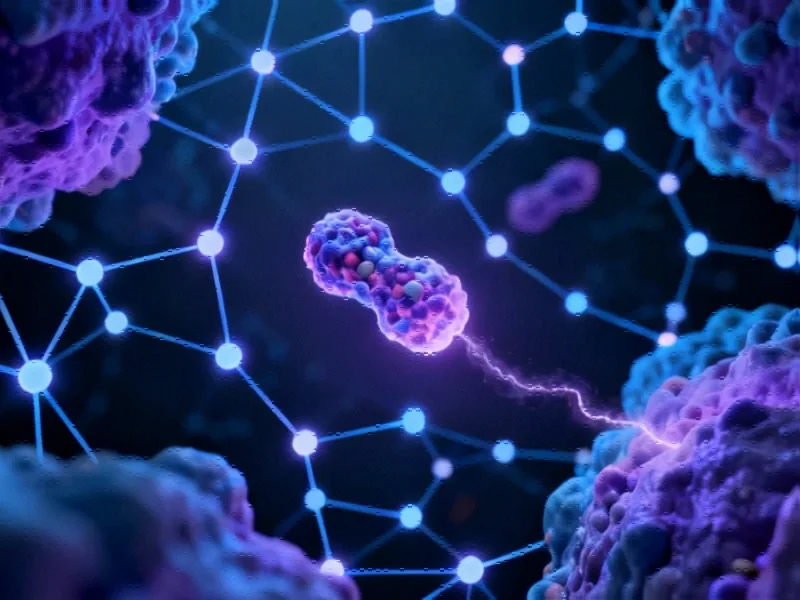Breakthrough Discovery in Cellular Waste Management
Scientists have identified a previously unknown cellular recycling mechanism that could revolutionize our understanding of how cells maintain health and prevent disease. The groundbreaking research reveals that optineurin (OPTN), a protein previously known for its role in autophagy, serves as a crucial adaptor in Golgi membrane-associated degradation (GOMED) – a specialized protein disposal system that targets ubiquitinated substrates passing through the Golgi apparatus.
This discovery represents the third known mechanism of ubiquitin-mediated proteolysis, alongside the well-established K48-ubiquitin chain-mediated proteasome degradation and linear/K63-ubiquitin chain-mediated autophagy pathways. The newly identified K33-ubiquitin chain-mediated GOMED pathway provides cells with another crucial tool for maintaining protein homeostasis and responding to cellular stress.
Understanding GOMED: The Golgi’s Quality Control System
GOMED functions as a specialized proteolysis mechanism that primarily degrades proteins that have passed through the Golgi apparatus. Unlike conventional autophagy, which can target various cellular components, GOMED specifically generates autophagosome-like and autolysosome-like structures from Golgi membranes to eliminate unwanted proteins.
Researchers demonstrated that GOMED operates selectively by recognizing substrates using K33-ubiquitin chains as “eat-me” signals, with OPTN serving as the critical adaptor molecule that facilitates this recognition process. This finding helps explain how cells can specifically target problematic proteins while sparing essential cellular components.
Experimental Evidence Confirms OPTN’s Crucial Role
Using multiple experimental approaches, the research team established OPTN’s essential function in GOMED. In Atg5-deficient mouse embryonic fibroblasts, where autophagy is blocked, researchers observed that etoposide treatment – which induces GOMED through genotoxic stress – caused a transient increase followed by decrease in OPTN levels. This reduction was prevented by chloroquine, a lysosomal degradation inhibitor, suggesting OPTN itself becomes a GOMED substrate while functioning as an adaptor.
Further confirmation came from silencing experiments, where OPTN knockdown substantially reduced GOMED induction. Rescue experiments using siRNA-resistant OPTN constructs successfully restored GOMED activity, providing compelling evidence for OPTN’s adaptor function. These findings align with recent discoveries in protein recycling pathways that are transforming our understanding of cellular maintenance.
Multiple Stressors Trigger OPTN-Mediated GOMED
The research team demonstrated that OPTN’s role in GOMED isn’t limited to genotoxic stress. When they treated cells with 1,3-cyclohexanebis(methylamine) (CBM), which inhibits protein trafficking from the Golgi to the plasma membrane, they observed similar OPTN-dependent GOMED induction. This suggests that OPTN-mediated GOMED represents a general cellular response to various stressors affecting Golgi function.
In both HeLa cells and specially engineered “Pentaknockout” cells lacking five key autophagy adaptor proteins, OPTN expression specifically restored GOMED activity without affecting autophagy. The OPTN-dependent structures showed clear colocalization with Golgi markers and Rab9, a protein crucial for GOMED function, confirming their Golgi origin.
Broader Implications for Cellular Health and Disease
The identification of OPTN’s role in GOMED has significant implications for understanding various disease processes. Given OPTN’s known associations with glaucoma, amyotrophic lateral sclerosis, and other neurodegenerative conditions, this discovery may reveal new pathological mechanisms and potential therapeutic targets.
Researchers also demonstrated that OPTN-mediated GOMED functions in mitochondrial removal during erythrocyte differentiation, suggesting this pathway plays important roles in normal development and cellular specialization. As we learn more about these sophisticated cellular quality control mechanisms, we gain deeper insights into fundamental biological processes that maintain health and prevent disease.
Connections to Broader Technological and Industrial Context
This fundamental biological research occurs alongside significant advancements in technological infrastructure that support scientific discovery. The sophisticated imaging and analysis techniques used in this study depend on robust computational resources and data management systems.
Recent developments in high-performance computing have enabled the complex data analysis required for understanding intricate cellular processes like GOMED. Similarly, the laboratory equipment and monitoring systems used in this research benefit from ongoing innovations in industrial computing that provide the reliability and precision necessary for cutting-edge biological research.
The discovery of new cellular quality control mechanisms like OPTN-mediated GOMED represents the type of fundamental research that drives medical progress. As scientists continue to unravel the complexities of cellular maintenance systems, we move closer to understanding – and potentially treating – numerous diseases rooted in protein mishandling and cellular stress response failures.
This research underscores the importance of continued investment in basic science, which often reveals unexpected connections and mechanisms that eventually translate to clinical applications. The identification of OPTN’s role in GOMED not only expands our understanding of cellular biology but also opens new avenues for investigating and potentially treating various human diseases.
This article aggregates information from publicly available sources. All trademarks and copyrights belong to their respective owners.
Note: Featured image is for illustrative purposes only and does not represent any specific product, service, or entity mentioned in this article.



